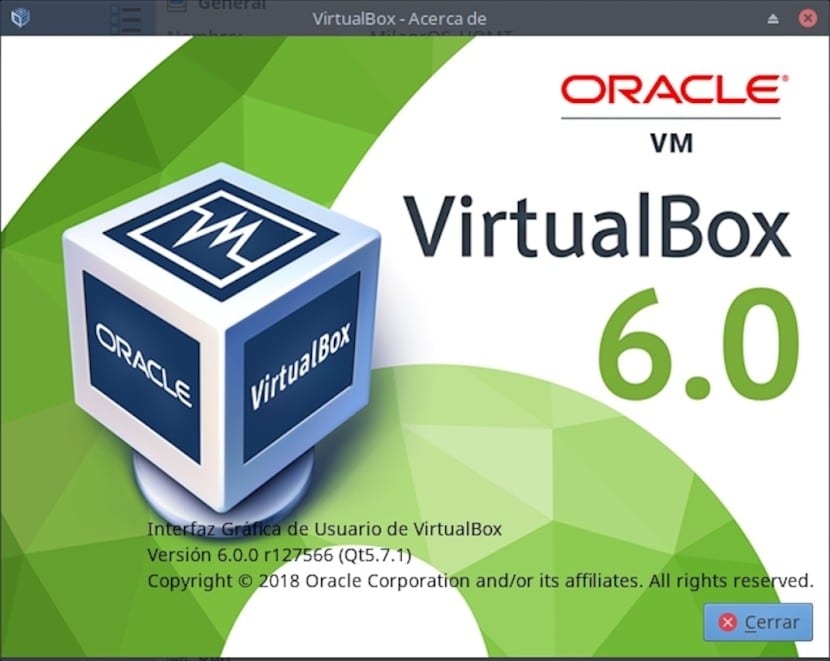
Virtualbox: Know in depth how to use this application
A few days ago Oracle has generated new corrective versions of the VirtualBox virtualization system 6.0.2 and 5.2.24, in which 13 corrections are noted.
VirtualBox is a popular cross-platform virtualization tool, with which we can virtualize any operating system (guest) from our operating system (host). With the help of VirtualBox we have the ability to test any OS without having to reformat our equipment.
Among the operating systems that VirtualBox supports are GNU / Linux, Mac OS X, OS / 2, Windows, Solaris, FreeBSD, MS-DOS, and many others. With which we can not only test different systems, but also We can also take advantage of virtualization to test hardware and applications in another system that is not ours.
Important changes in version 6.0.2
In this new version of fix a new window has been added to the user interface to create a virtual optical disk.
As well as an option to select the drives of the host system has been added to the home page.
The interface solves problems with creating shortcuts to run virtual machines and attach empty optical disk drives.
In addition to Linux-based guest systems, issues resolved with driver builds on SLES 12.4 environment and driver builds for shared directories were established on systems with older Linux kernels.
As for Linux support it has added support for resetting USB devices (previously, requests from guest systems to reset USB devices were ignored).
PCnet removed a backward change, which led to problems with defining emulated hardware drivers for guest systems.
Components for Linux-based hosts eliminate conflict between desktop files offered by Oracle and included in the Debian distribution.
Fixed a bug that caused the VirtualBoxVM command to be inaccessible on Linux and macOS hosts.
In addition to Windows-based guest systems, fixes have been made to resolve issues with the VBoxSVGA driver when using multiple monitors or disabling support to speed up 3D operations.
Fixed issue with writing to shared directories from OS / 2 guest systems.
Update: New issues have been fixed for 28 vulnerabilities, of which 3 are Critically Endangered (CVSS Score 8.8). Details are not disclosed. In the release note, the security troubleshooting is not announced.
How to install VirtualBox 6.0.2 on Linux?

For those who are users of Debian, Ubuntu and derivatives, we proceed to install the new version, we continue in the terminal and execute the following commands:
First we must add the repository to our sources.list
sudo sh -c 'echo "deb http://download.virtualbox.org/virtualbox/debian $(lsb_release -sc) contrib" >> /etc/apt/sources.list.d/virtualbox.list'
Now we proceed to import the public key:
wget -q https://www.virtualbox.org/download/oracle_vbox_2016.asc -O- | sudo apt-key add -
Now we proceed to update our list of repositories:
sudo apt-get update
It is extremely important to have the following, so that we guarantee the operation of VirtualBox:
sudo apt-get -y install gcc make linux-headers-$(uname -r) dkms
And finally we proceed to install the application to our system:
sudo apt-get install virtualbox-6.0
While for those who are users of Fedora, RHEL, CentOS, we must do the following, which is to download the package with:
wget https://download.virtualbox.org/virtualbox/6.0.2/VirtualBox-6.0-6.0.2_128162_fedora29-1.x86_64.rpm
wget https://www.virtualbox.org/download/oracle_vbox.asc
In the case of OpenSUSE 15 the package for your system is this:
wget https://download.virtualbox.org/virtualbox/6.0.2/VirtualBox-6.0-6.0.2_128162_openSUSE150-1.x86_64.rpm
After that we type:
sudo rpm --import oracle_vbox.asc
And we install with:
sudo rpm -i VirtualBox-6.0-6.0.2_128162_fedora29-1.x86_64.rpm
Now to verify that the installation was done:
VBoxManage -v
In the case of Arch Linux, you can install from AUR, even though some services are required for Systemd, so it is recommended that you use the Wiki in order to install.
As an additional step we can improve the functioning of VirtualBox With the help of a package, this package enables VRDP (Virtual Remote Desktop Protocol), solves the problem with the small resolution that VirtualBox runs, and many other improvements.
To install it, run the following commands:
curl https://download.virtualbox.org/virtualbox/6.0.2/Oracle_VM_VirtualBox_Extension_Pack-6.0.2.vbox-extpack sudo VBoxManage extpack install Oracle_VM_VirtualBox_Extension_Pack-6.0.2.vbox-extpack
We accept the terms and conditions and install the package.
To verify that it was installed correctly:
VBoxManage list extpacks
For it to automatically recognize "VBoxGuestAdditios.iso", "sudo apt update" is not enough if the packages are not up to date. In order for the packages to also be updated and to avoid errors, the "sudo apt update && sudo apt upgrade"
Excellent tutorial completed by Rafael. Then I applied the "sudo apt autoremove" to clean up.